MARIANI’S
Virtual Gourmet
September 25,
2016
NEWSLETTER
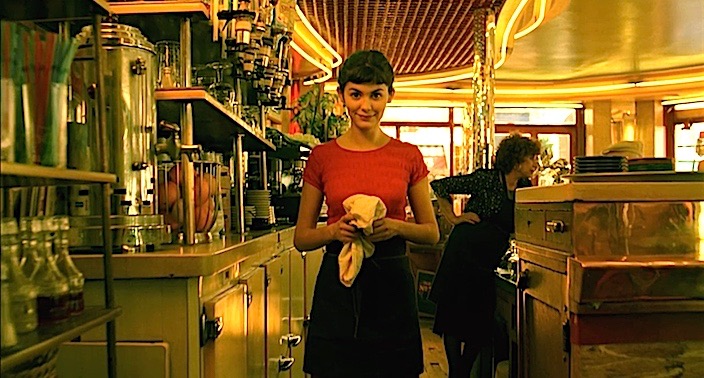
❖❖❖
THIS WEEK
THE AMERICAN CLUB
By John Mariani
NEW YORK CORNER
BAGATELLE
By John Mariani
NOTES FROM THE WINE CELLAR
ANGÉLUS TAKES ITS TIME
ENTERING THE 21ST CENTURY
By John Mariani
❖❖❖
THE AMERICAN CLUB
By John Mariani

As noted in my article last week about Kohler,
Wisconsin, The American Club opened in 1918
as living quarters for the Kohler company’s
factory workers, complete with pub, bowling alley
and barbershop, all surrounded by 500 acres of
lush woodlands and rivers. In 1978
the building was placed 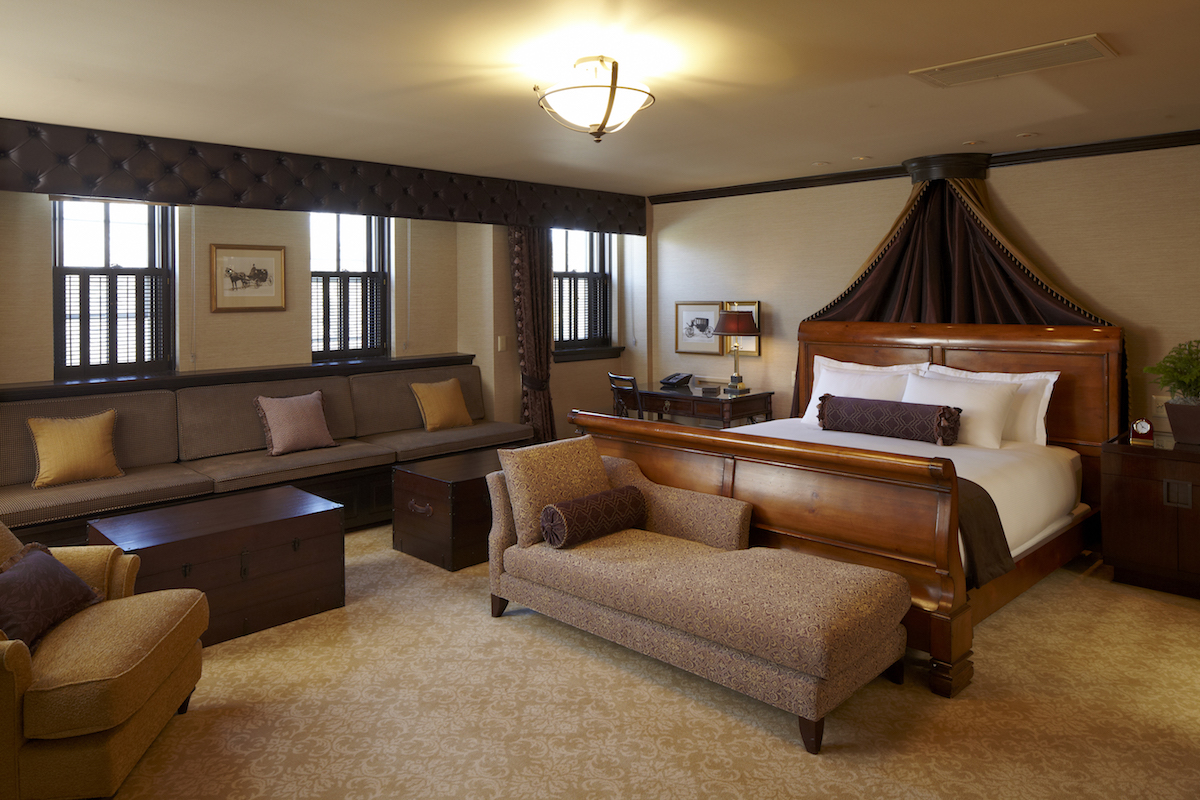 on the National Register
of Historic Places.
on the National Register
of Historic Places.
After being closed for three years, The
American Club was reconfigured in 1981 as a grand
inn, and it is as splendid a Late Gothic-Victorian
structure as may be found in the nation. The
original 100-foot flagpole still flies an
American banner, and the magnificent blue slate roof
has been carefully maintained.
Every inch of the building was
restored to contemporary standards of luxury, its
oak paneling buffed and expanded, and each guest
room was created to honor Americans of unique
achievement, including George Washington, Abraham
Lincoln, Mary Pickford, Ernest Hemingway and Lou
Gehrig. My wife and I stayed in the John James
Audubon room, decorated with reproductions of the
artist’s work and memorabilia. All the rooms are spacious,
many with gas fireplaces, all with minibars, and,
since this is a Kohler showcase, you can only
imagine how luxuriously the bathrooms are designed
and appointed.
You could hardly conceive of a better
advertisement for good plumbing.
 I particularly loved the
Library (left)
, where I could spend days on end picking through
volumes of classic American and European literature
from the shelves, settling down in a comfortable
chair and ordering tea or a cocktail as I wile away
hours ripping through a volume or two of James
Fenimore Cooper or boning up on Wisconsin wildlife.
I particularly loved the
Library (left)
, where I could spend days on end picking through
volumes of classic American and European literature
from the shelves, settling down in a comfortable
chair and ordering tea or a cocktail as I wile away
hours ripping through a volume or two of James
Fenimore Cooper or boning up on Wisconsin wildlife.
Amenities are first rate
throughout, and I had no trouble with WiFi. Kohler
has also initiated a children’s program, and while
this is very much an adult hotel in cast and
sophistication, younger children can sill enjoy it;
teenagers will probably sit in their room and play
with their iPhones (as they always do). Shuttle
carts take you wherever you wish on the property, including four world-class golf
courses designed by the noted (some say notorious)
architect Pete Dye.
There are six dining
rooms in the Club, and where the bowling alley once
stood there is now the cheery Horse & Plow Pub,
decked out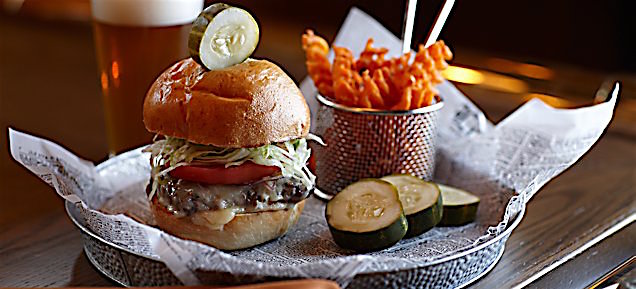 with
antique farm tools—the tabletops are made from the
bowling alley planking—and serving very good
American fare. Here I wholly enjoyed a
beer-and-cheese soup, a juicy burger piled high with
Wisconsin sharp cheddar on a housemade Stieber bun (right), and
some hearty grilled bratwurst served with
bacon-studded sauerkraut, grilled onions and
Stout-spiked mustard on a toasted hard roll.
with
antique farm tools—the tabletops are made from the
bowling alley planking—and serving very good
American fare. Here I wholly enjoyed a
beer-and-cheese soup, a juicy burger piled high with
Wisconsin sharp cheddar on a housemade Stieber bun (right), and
some hearty grilled bratwurst served with
bacon-studded sauerkraut, grilled onions and
Stout-spiked mustard on a toasted hard roll.
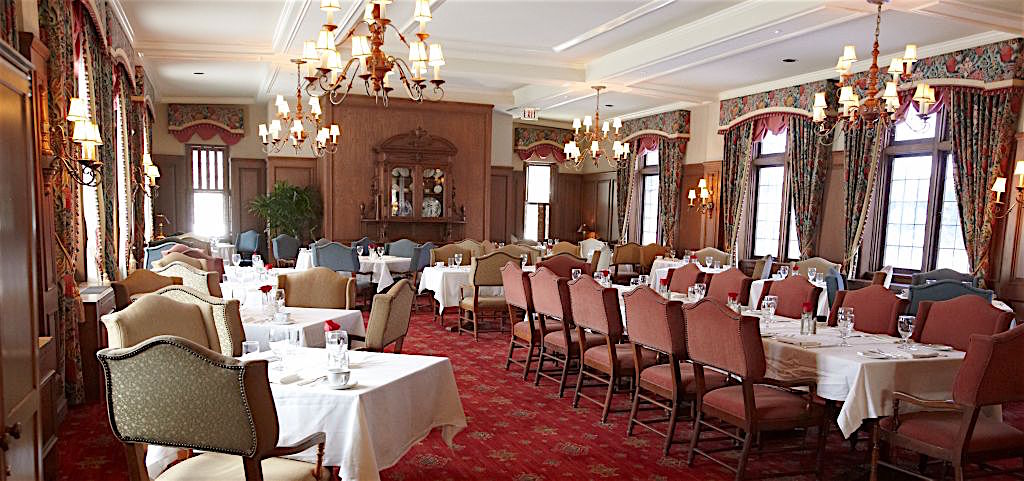 The most
formal dining venue in the Club is the Wisconsin Room (below), where
seasonality invests a continental-style menu
featuring items like Great Lakes perch and Wisconsin
char along with bison tenderloin and grass-fed Prime
rib, with main courses ranging from $25 to $54 and a
three-course “Farmer’s Tasting Menu” at $45. Dishes
tend to be overwrought, when simpler renditions
would be better.
The most
formal dining venue in the Club is the Wisconsin Room (below), where
seasonality invests a continental-style menu
featuring items like Great Lakes perch and Wisconsin
char along with bison tenderloin and grass-fed Prime
rib, with main courses ranging from $25 to $54 and a
three-course “Farmer’s Tasting Menu” at $45. Dishes
tend to be overwrought, when simpler renditions
would be better.
A former laundry room has been
converted into a warren of small, intimate dining
areas called the Immigrant
Restaurant
& Winery Bar, each reflecting a
different ethnic heritage of the Kohler workers of
the past. This
is the most ambitious of the restaurants at the
Club, with entrée prices from $46 to $62, and wine
pairings are crafted from a stellar 40-page list,
also featured at The Winery bar next to the
restaurant. Here
wine and cheese tastings are part of the nightly
fare, and it’s a beautiful, secluded spot in which
to end an evening with a glass of Port or Brandy and
talk about one’s experience on the golf greens that
afternoon.
Outside the main building are
other venues where one can stay or eat, some geared
to the golf courses on which they sit: Black Wolf Run (right),
magnificently timbered, features an American grill
menu with dishes like corn-and-sausage chowder ($7),
dill and citrus walleye 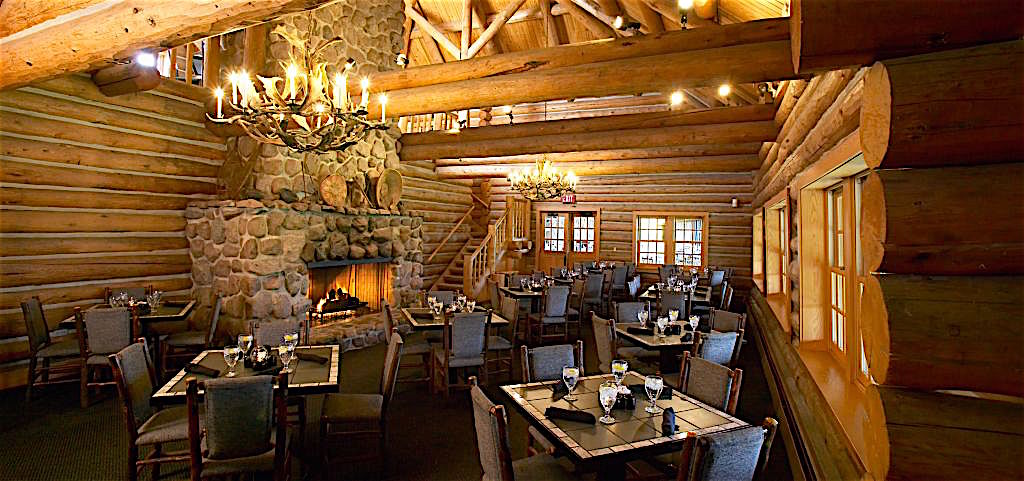 pike on
sourdough bread ($14), and stuffed cheese steak
($11); if still warm, outside on the terrace you can
enjoy your meal and drinks in front of a grand
fieldstone fireplace.
pike on
sourdough bread ($14), and stuffed cheese steak
($11); if still warm, outside on the terrace you can
enjoy your meal and drinks in front of a grand
fieldstone fireplace.
My
favorite of the estate’s smaller restaurants was
River Wildlife’s Lodge
Restaurant, set in a log cabin (below) for
which the term rustic is a bit ingenuous. Still,
notes its brochure, "Everything carried in must be
carried out." For, although it has all the
lineaments of a cabin in the woods, it is also the
epitome of an American style that evokes Beretta
shotguns, Irish tweeds, Ralph Lauren boots, stacks
of magazines like Sports Afield
and Field
& Stream,
a copy of Hemingway’s Nick Adams stories and
a good stock of rare Scotches. Here the menu is
happily Midwestern, with excellent, hearty
soups glaze ($6), pheasant BLT with
applewood bacon ($16), and autumn fruit crisp
($8). Dinner is served at the Lodge on
weekends.
 Off site, in a village
called the Shops at Woodlake, Kohler also runs the Craverie Chocolatier
Café, using the resort’s own recipes for
fancy chocolates—tastings are available—and also
offering a light but substantial menu of soups and
sandwiches, as well as freshly baked pastries and
ice creams. The dishes include roasted cauliflower
soup and Waldorf chicken salad wrap, and for
breakfast an egg and Wisconsin cheddar cheese
croissant.
Off site, in a village
called the Shops at Woodlake, Kohler also runs the Craverie Chocolatier
Café, using the resort’s own recipes for
fancy chocolates—tastings are available—and also
offering a light but substantial menu of soups and
sandwiches, as well as freshly baked pastries and
ice creams. The dishes include roasted cauliflower
soup and Waldorf chicken salad wrap, and for
breakfast an egg and Wisconsin cheddar cheese
croissant.
Also at the Shops is Cucina, a
good-looking modern Italian restaurant that needs
improvement in the kitchen; the best way to go is
with the variety of steaks and chops cooked over a
wood grill, with main courses $21-$35.
Kohler also has some superb
private clubs, including the baronial Riverbend, with
two dining rooms.
Destination
Kohler is well named, for although it’s only an hour
from Milwaukee, it seems remote in the sense of
being of another, quieter, slower paced era, buoyed
by Midwestern hospitality, far from the bustle and
rush of a big city.
❖❖❖
By John Mariani
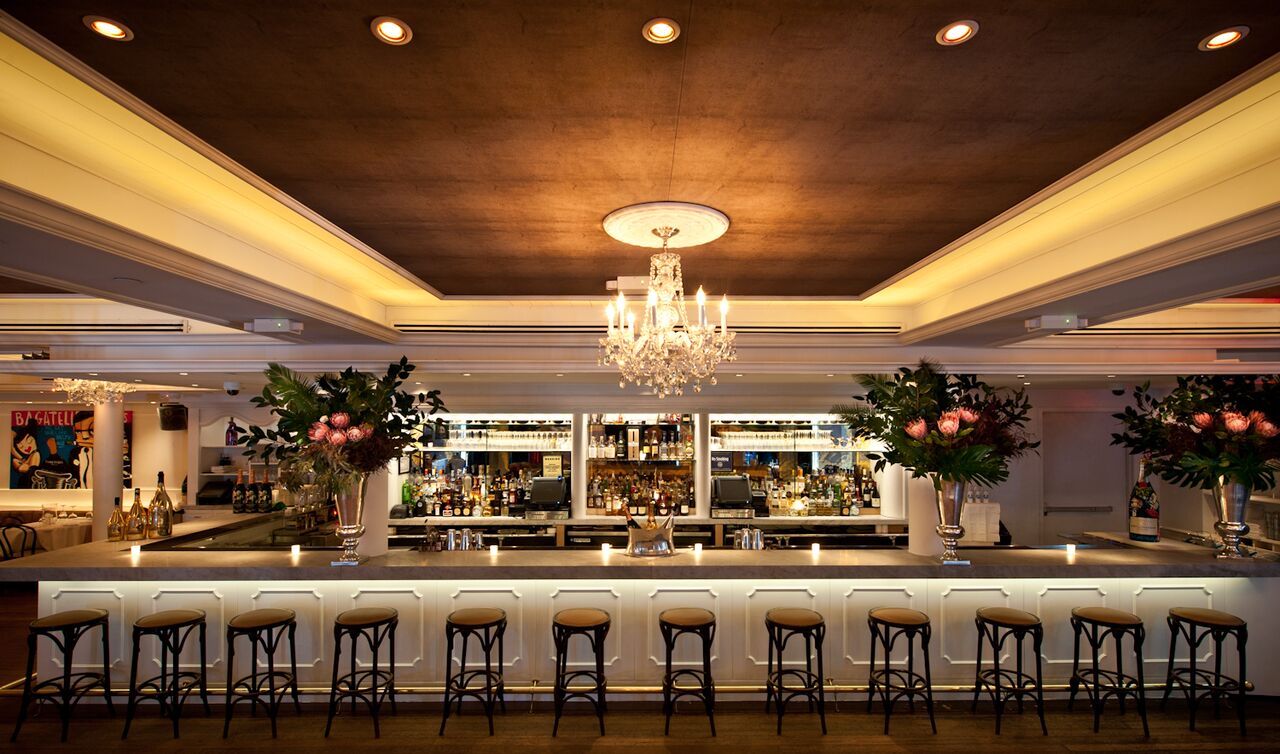 BAGATELLE
BAGATELLE1 Little West 12th Street (near Hudson Street)
212-488-2110
bagatellenyc.com
When entrepreneurs Aymeric
Clemente and Remi Laba opened the first
Riviera-styled Bagatelle location in NYC's Meat
Packing District in 2008, it was decidedly
intended to be a scene—or, as Clemente put it,
“a vibe restaurant”—whose decadent Saturday
brunch was the talk of the town, even during the
height of the recession. Seven
branches followed in ports like Rio, San Tropez
and St. Barts.
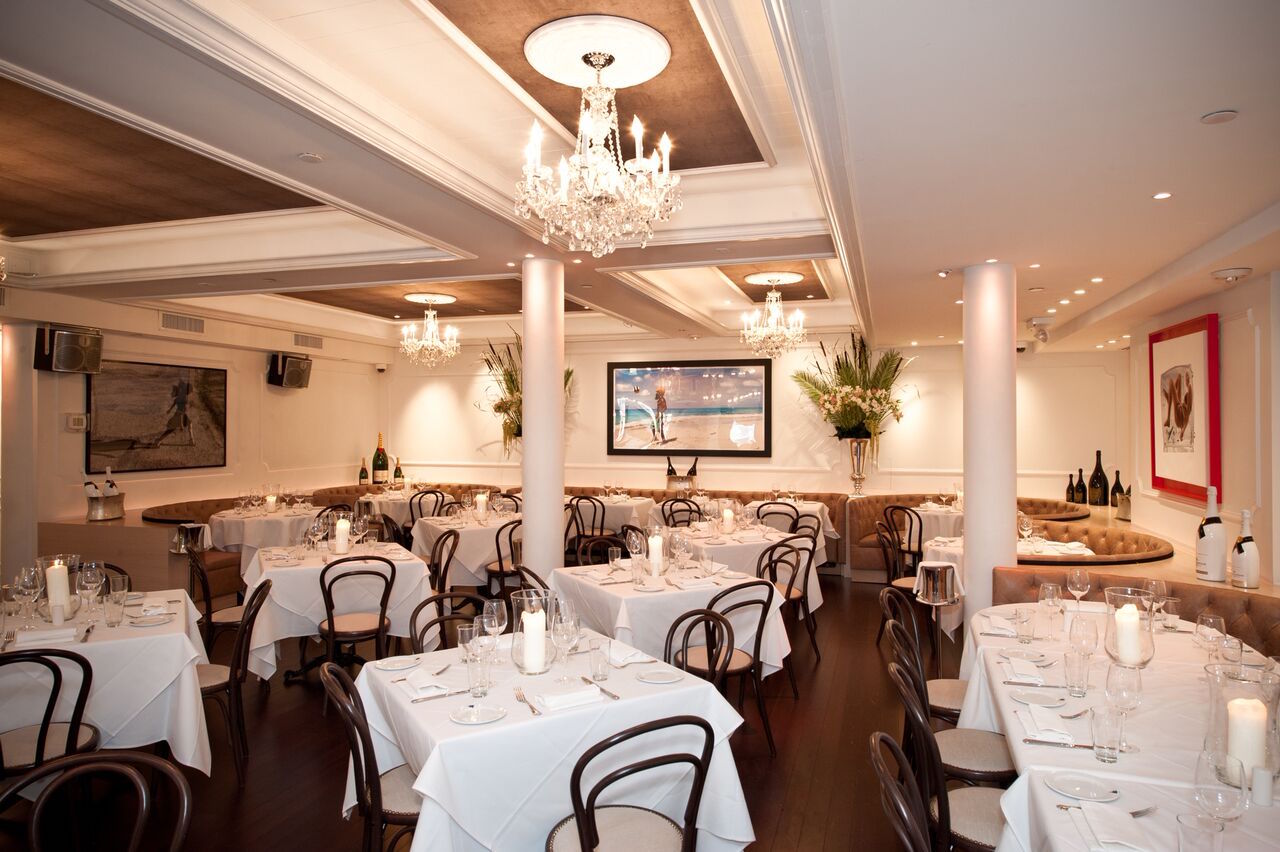 “As the waiter soars
through the air, he does so against a backdrop of
patrons fist-pumping Champagne flutes, flashing
cameras capturing pictures ripe for Facebook and a
dozen young women clad in sequins, stilettos and
Chanel bags climbing onto chairs, banquettes, even
tables—any elevated surface that is sturdy enough
to dance on.” So wrote a New York
Times reporter in 2009, noting that,
“Through the window this afternoon, Mr. Laba
observed two young men talking to the doorman
about securing a table. `They will be turned
away,’ he predicted. And, if they had been two
beautiful women? `They’ll be sent to the bar,’ he
said. `I may even seat them.’”
“As the waiter soars
through the air, he does so against a backdrop of
patrons fist-pumping Champagne flutes, flashing
cameras capturing pictures ripe for Facebook and a
dozen young women clad in sequins, stilettos and
Chanel bags climbing onto chairs, banquettes, even
tables—any elevated surface that is sturdy enough
to dance on.” So wrote a New York
Times reporter in 2009, noting that,
“Through the window this afternoon, Mr. Laba
observed two young men talking to the doorman
about securing a table. `They will be turned
away,’ he predicted. And, if they had been two
beautiful women? `They’ll be sent to the bar,’ he
said. `I may even seat them.’”
Music via a D.J. began after 11
p.m. Purely as a stunt, a $1,000 “Mauboussin Mega
Sundae” consisting of vanilla ice cream, Dom
Pérignon Rosé and sorbet topped with chocolate
truffles, macarons, whipped cream, chocolate vodka
sauce and "gilded brownies" with gold leaf
and a ring of gold and black steel was promoted on
the menu.
So evident was the intent of
Bagatelle’s owners to make their operation a scene
in the days when Eminem and the Black Eyed Peas
were all the rage that the restaurant was largely
ignored by the food press (the Times
reported on but never reviewed it). Now, in a new
location a block away and light years from 2008,
Clemente and Laba are trying to garner more
respect for the food, and in hiring young Nicolas
Frezal (below),
a native  of the South of France,
the menu most certainly deserves more serious
attention. Frezal
is a graduate of top Michelin restaurants like Le
Taillevent, Restaurant Le Meurice, and L'Ami Jean
in Paris, before moving to NYC to work at
Restaurant Daniel and as sous chef at Jean-George
Vongerichten’s The Mark. Now, at Bagatelle, Frezal
intends to make his own mark.
of the South of France,
the menu most certainly deserves more serious
attention. Frezal
is a graduate of top Michelin restaurants like Le
Taillevent, Restaurant Le Meurice, and L'Ami Jean
in Paris, before moving to NYC to work at
Restaurant Daniel and as sous chef at Jean-George
Vongerichten’s The Mark. Now, at Bagatelle, Frezal
intends to make his own mark.
His steak tartare ($20) shows
him as his elemental best, gambling everything on
the freshest, finest chopped beef, set on crispy
rice cakes to add more texture. The
tomatoes in his tomato salad with goat’s cheese,
kimchi lime paste and a vinaigrette ($16) are as
sweet as they come right now, while his grilled
octopus ($19), done à la Niçoise
with Kalamata olives, is of just the right
tenderness without being overcooked and the acidic
addition of tomato confit, along with potatoes and
aïoli, makes this one of the best in town. He also
does a few creditable pizzas—really more
flatbreads—one with so-so Australian truffles
shaved on top ($27— but more about this price
later). Gnocchi Parisienne
($25, $36 with truffles), which
more often than not is a floury, mushy mess, was a
textbook example of how they should be made, with
a truffle sauce (left).
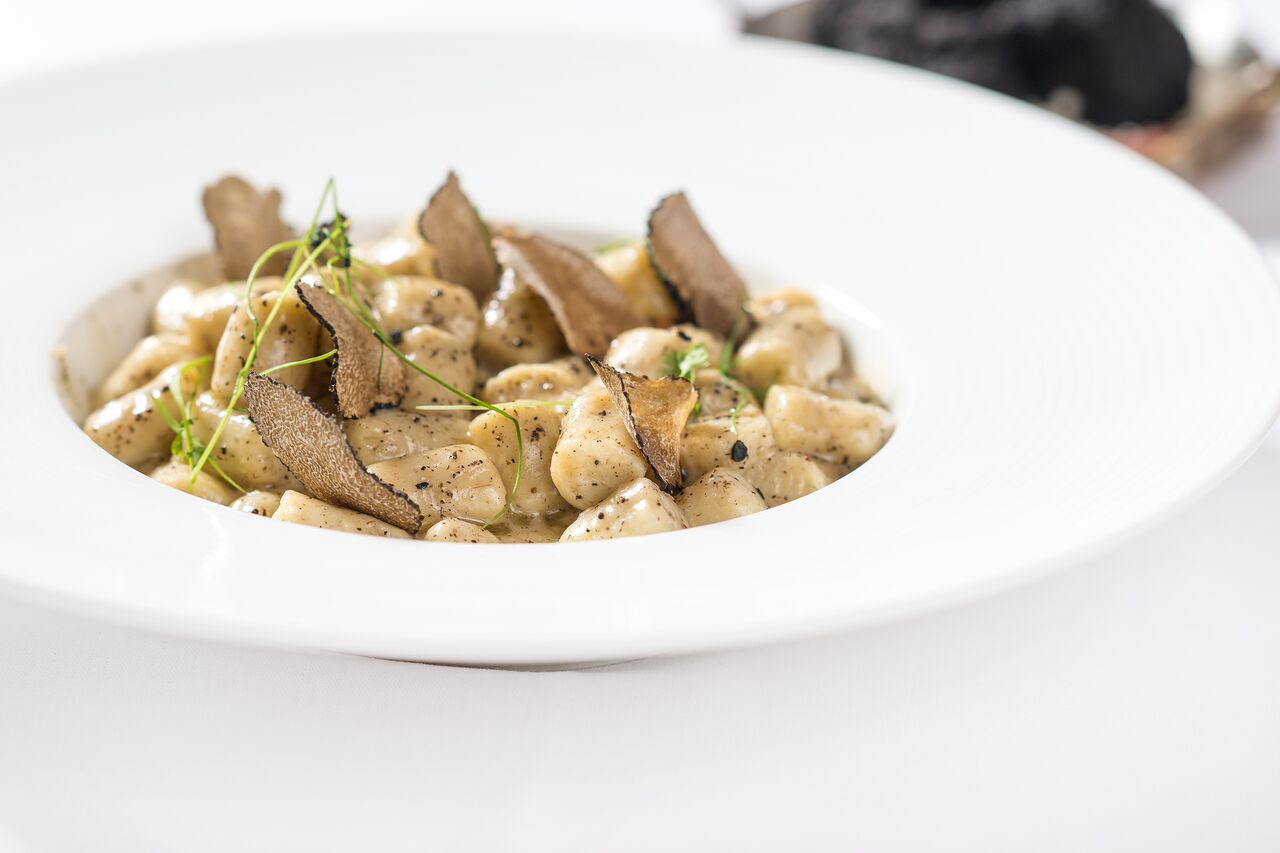 Among the
main courses I enjoyed were impeccably sweet
scallops with sautéed quinoa, English peas and a
lush Parmesan saffron sauce ($39). So,
too, large prawns came with a delicious herbed
risotto and a light but rich Pastis-scented cream
sauce ($48).
A simply roasted half chicken ($35, $69
whole), wonderfully crisp, was also treated to
truffles (below).
Among the
main courses I enjoyed were impeccably sweet
scallops with sautéed quinoa, English peas and a
lush Parmesan saffron sauce ($39). So,
too, large prawns came with a delicious herbed
risotto and a light but rich Pastis-scented cream
sauce ($48).
A simply roasted half chicken ($35, $69
whole), wonderfully crisp, was also treated to
truffles (below).
A bavette
of Australian wagyu ($45) showed why it is just
not worth the price or effort to import beef that
doesn’t come close to the flavor of a USDA Prime
strip steak.
Desserts ($13) are very
traditional, but all very good—crème brûlée,
chocolate mousse, peaches and cream.
Frezal has made his intentions
clear that he wants people to love his cuisine,
but the management does not make it easy for a
guest to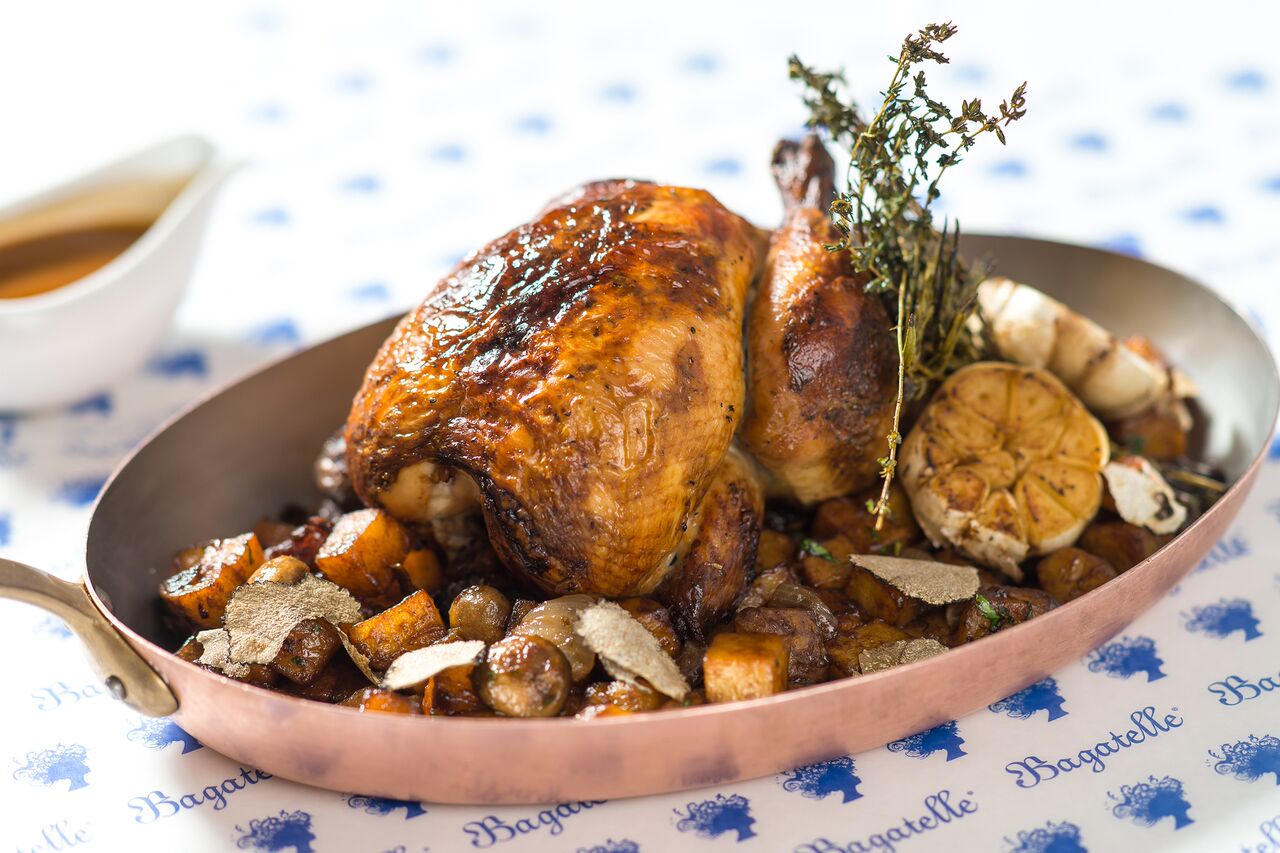 want to
return. Sad
to say, they gouge: five bottles of water, not
ordered, were $50 on the bill, and somehow for
four people the waiter managed to shave four of
those inferior Australian truffles onto our food
for a total of $156, with no mention of price! The
mark-ups on the wine list also are very high, with
few bottles under $100. (Incidentally, Bagatelle’s
bill lists percentages for tipping, apparently because
so many Europeans pretend
they don’t know they’re supposed to tip in
America.)
want to
return. Sad
to say, they gouge: five bottles of water, not
ordered, were $50 on the bill, and somehow for
four people the waiter managed to shave four of
those inferior Australian truffles onto our food
for a total of $156, with no mention of price! The
mark-ups on the wine list also are very high, with
few bottles under $100. (Incidentally, Bagatelle’s
bill lists percentages for tipping, apparently because
so many Europeans pretend
they don’t know they’re supposed to tip in
America.)
These deliberate overcharges
marred what, up until then, had been an enchanting
evening in a place I’d certainly go back to for
Frezal’s food—he said he’d make me a classic
bouillabaisse this fall—but it seemed clear that
the owners believe their clientele are of a kind
that doesn’t bother to look at their bill. They
really, really should.
Bagatelle is open for lunch and
dinner nightly; Brunch on Sat.
❖❖❖
NOTES
FROM THE WINE CELLAR
ANGÉLUS TAKES ITS TIME ENTERING THE
21ST CENTURY
By
John Mariani
Photos by G. deLaubier
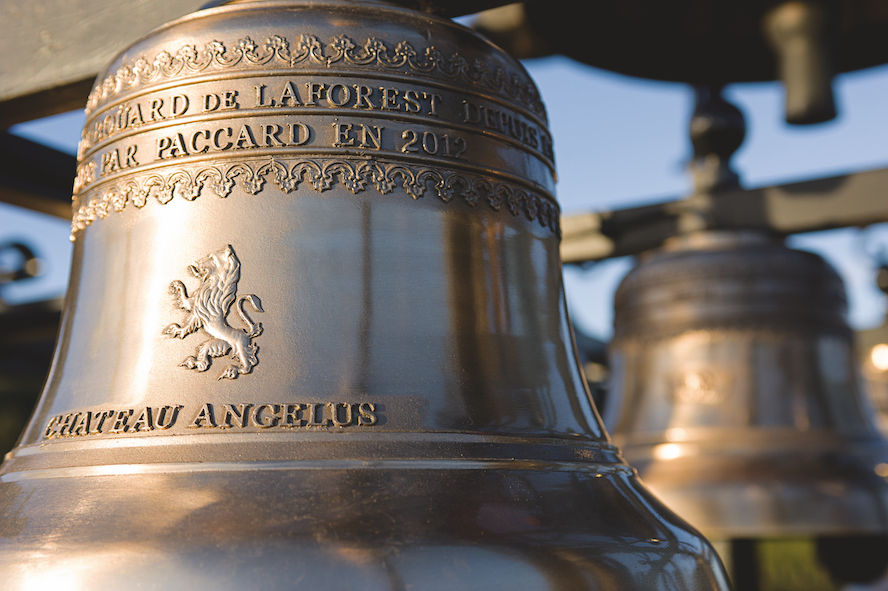 For
me the best part of being a wine writer is not
the opportunity to taste so many wines in so
many places but to meet the passionate
winemakers who have devoted their lives to
maintaining a long history of excellence,
whether it’s an Italian like Angelo Gaja or a
Californian like Michael Mondavi. So,
being invited to lunch in New York at Le
Bernardin by Stéphanie de Boüard-Rivoal of
Angélus in Saint-Emilion was an occasion I would
not have traded for a thousand tasting sessions.
For
me the best part of being a wine writer is not
the opportunity to taste so many wines in so
many places but to meet the passionate
winemakers who have devoted their lives to
maintaining a long history of excellence,
whether it’s an Italian like Angelo Gaja or a
Californian like Michael Mondavi. So,
being invited to lunch in New York at Le
Bernardin by Stéphanie de Boüard-Rivoal of
Angélus in Saint-Emilion was an occasion I would
not have traded for a thousand tasting sessions.
Angélus takes its name from a
centuries-old Catholic tradition of reciting
prayers three times a day, often marked by the
pealing of church bells in the morning, at midday
and in the evening.
The estate itself dates to 1795, when
Charles Souffrain de Lavergne and his wife,
Catherine-Sophie, made their home in the wine
region of Saint-Emilion. At the beginning of the 20th
century ownership passed to the Laforest family,
which runs it today under Hubert de Boüard de
Laforest, Jean-Bernard Grenié and, as of 2012,
Stéphanie de Boüard-Rivoal, who is part of the
eighth generation of the Boüard family; 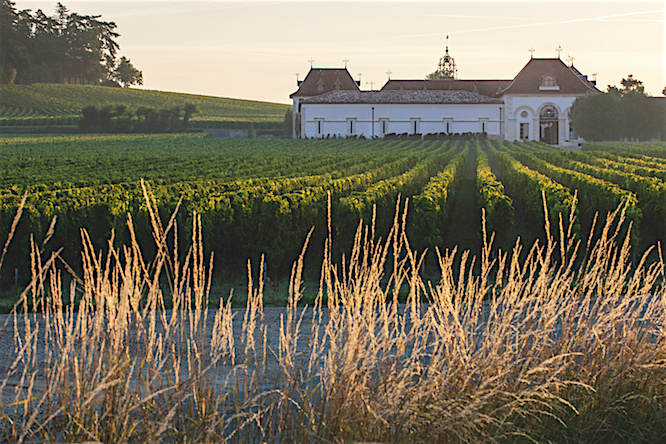 her cousin
,Thierry Grenie-Boüard, has recently joined her.
her cousin
,Thierry Grenie-Boüard, has recently joined her.
It
was Hubert who elevated Angélus’s status in
Saint-Emilion, which had enjoyed the Grand Cru
appellation since the first classification of
Saint-Emilion wines in 1954, but rose to Premier
Grand Cru in the (albeit controversial) 2012
re-classification.
(The others are Château Pavie and Château
Ausone.) Angélus’s
96-acre vineyard lies in a natural amphitheater
with concentrated sunlight and good drainage,
where the Merlot grows well on a clay-rich hill,
while the Cabernet Franc enjoys the clay and
limestone at the foot. The blend at Angélus
is usually around 60% Cab Franc and 40% Merlot,
without the Cabernet Sauvignon that distinguishes
most of Bordeaux’s red wines, although the estate
grows a small amount of the grape.
At one time Angélus wines spent
no time aging in oak, but Hubert and oenologist
Emmanuele d’Aligny-Fulchi now ferment in stainless
steel, concrete and oak vats, with 18-24 months
aging and bottling taking place 20 to 26 months
after harvest, for a production of about 100,000
bottles. (The estate also makes a second label, Le
Carillon d’Angélus.)
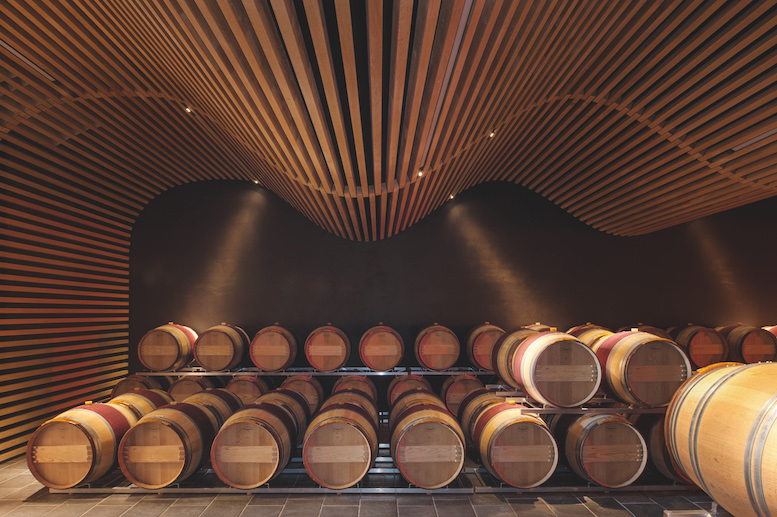 Stéphanie
de Bouard-Rivoal, 34 (below), has all the breeding of
what would otherwise be called a “gentleman
vigneron,” but she is actually the third woman to
preside over the estate. Tall, with long honey-brown
hair, she speaks fluent English and enjoys telling
of how fiercely committed her family is to
Angélus, noting that, “My great uncle was proud
that he had never set foot on the Left Bank of the
Garonne River,” which bisects Bordeaux.
Stéphanie
de Bouard-Rivoal, 34 (below), has all the breeding of
what would otherwise be called a “gentleman
vigneron,” but she is actually the third woman to
preside over the estate. Tall, with long honey-brown
hair, she speaks fluent English and enjoys telling
of how fiercely committed her family is to
Angélus, noting that, “My great uncle was proud
that he had never set foot on the Left Bank of the
Garonne River,” which bisects Bordeaux.
Stéphanie, on the other hand,
is a global ambassador for the estate,
insisting with fervor, “The commitment for me is almost
like a priestly vocation, which I take up with
faith, passion and gratitude. We are only the
guardians of a history that preceded us and will
survive us, so our role is to sustain it in the
best conditions we will be able to achieve.” Prior
to her taking over, the estate was able to coax
James Bond to drink L’Angélus in Casino Royale
(2005) and she made sure he did so again in Spectre
(2015).
estate,
insisting with fervor, “The commitment for me is almost
like a priestly vocation, which I take up with
faith, passion and gratitude. We are only the
guardians of a history that preceded us and will
survive us, so our role is to sustain it in the
best conditions we will be able to achieve.” Prior
to her taking over, the estate was able to coax
James Bond to drink L’Angélus in Casino Royale
(2005) and she made sure he did so again in Spectre
(2015).
Over
a lunch of tagliatelle noodles with crab, scallop
and lobster in a black truffle emulsion, then
pan-roasted squab with truffled Savoy cabbage and
a red wine salmis
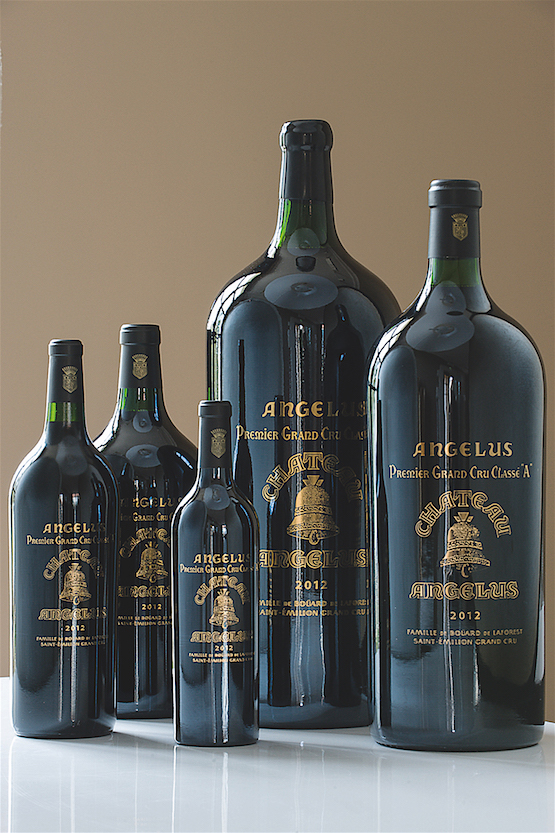 sauce, we tasted
two vintages of L’Angélus, 1999 and 2004. Both
reminded me of the distinctive flavor of
Saint-Emilion at its best: robust but velvety,
supple but with good tannins, fleshy but well
textured, always revealing an identifiable
brick-like aroma. They mature earlier than many
Bordeaux and are, therefore, easy to love long
before the wines of the Médoc. The
1999 was a difficult vintage because hail forced
early picking,
but it is nevertheless a wine of real
character that shows off its limestone-clay
terroir well.
The depth of the wine is now in its glory,
and this is a vintage to drink now.
sauce, we tasted
two vintages of L’Angélus, 1999 and 2004. Both
reminded me of the distinctive flavor of
Saint-Emilion at its best: robust but velvety,
supple but with good tannins, fleshy but well
textured, always revealing an identifiable
brick-like aroma. They mature earlier than many
Bordeaux and are, therefore, easy to love long
before the wines of the Médoc. The
1999 was a difficult vintage because hail forced
early picking,
but it is nevertheless a wine of real
character that shows off its limestone-clay
terroir well.
The depth of the wine is now in its glory,
and this is a vintage to drink now.
The 2004, which Angélus
characterizes as “Le Savoureux,” began and
continued to worry vignerons through summer, but
by the time of harvest in mid-October conditions
had improved greatly, resulting in a wine still
showing a freshness of fruit and a mellowing of
tannins, all rounded by the Merlot and given spice
by the Cabernet Franc, which makes the estate’s
suggestion that the wine should be at its best in
2025 to 2035 disappointing to all, like myself,
who would love drinking this every year till then.
Angélus has a new label, but in
the very best sense, it’s the same old wine in a
brand new bottle.
The label is a nod to the 21st century, but
the wine is testament to more than two centuries
of good soil and good stewardship.
❖❖❖
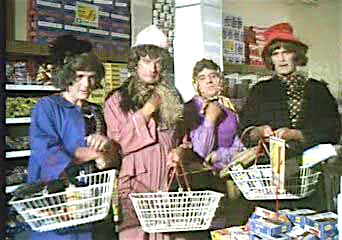
WHY
THERE'LL ALWAYS
BE AN ENGLAND!
The Manchester Evening News reported that the
The Greater Manchester Police Trafford South posted an
incident that, “Whilst shopping, the lady was challenged
by an unknown female who grabbed her trolley and
demanded the money she had withdrawn. The 86 year old
lady then defended herself by repeatedly hitting the
female offender over the head with a packet of bacon.
The offender then retreated and made off from the
supermarket.”
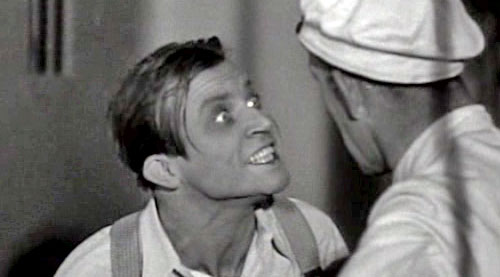
ON YOUR COKE CONSUMPTION
"The rum-and-cola at BlackTail, a new
Cuban-themed bar in lower Manhattan from the Dead Rabbit
team, is poorly named. It is not a rum-and-cola because,
let’s be honest, it is not merely rum plus cola. It’s
more like rum times cola. Rum to the power of cola. It’s
Coke, at home in Atlanta, receiving rum-scented love
letters from a paramour abroad. On a scale of 1 to 10,
this rum-and-Coke is an 8, but that’s not an “8.” It’s
an infinity symbol, standing at attention, full of
wokeness."--"This Rum-and-Coke Might Be New York’s Most
Sophisticated New Drink" By Richard Morgan, Grub Street NY Magazine.
Any of John Mariani's books below may be ordered from amazon.com.
 The
Hound in Heaven (21st Century Lion Books)
is a novella, and for anyone who loves dogs,
Christmas, romance, inspiration, even the supernatural, I
hope you'll find this to be a treasured favorite.
The story concerns how, after a New England teacher,
his wife and their two daughters adopt a stray puppy found
in their barn in northern Maine, their lives seem full of
promise. But when tragedy strikes, their wonderful dog
Lazarus and the spirit of Christmas are the only things
that may bring his master back from the edge of
despair.
The
Hound in Heaven (21st Century Lion Books)
is a novella, and for anyone who loves dogs,
Christmas, romance, inspiration, even the supernatural, I
hope you'll find this to be a treasured favorite.
The story concerns how, after a New England teacher,
his wife and their two daughters adopt a stray puppy found
in their barn in northern Maine, their lives seem full of
promise. But when tragedy strikes, their wonderful dog
Lazarus and the spirit of Christmas are the only things
that may bring his master back from the edge of
despair. WATCH THE VIDEO!
“What a huge surprise turn this story took! I was completely stunned! I truly enjoyed this book and its message.” – Actress Ali MacGraw
“He had me at Page One. The amount of heart, human insight, soul searching, and deft literary strength that John Mariani pours into this airtight novella is vertigo-inducing. Perhaps ‘wow’ would be the best comment.” – James Dalessandro, author of Bohemian Heart and 1906.
“John Mariani’s Hound in Heaven starts with a well-painted portrayal of an American family, along with the requisite dog. A surprise event flips the action of the novel and captures us for a voyage leading to a hopeful and heart-warming message. A page turning, one sitting read, it’s the perfect antidote for the winter and promotion of holiday celebration.” – Ann Pearlman, author of The Christmas Cookie Club and A Gift for my Sister.
“John Mariani’s concise, achingly beautiful novella pulls a literary rabbit out of a hat – a mash-up of the cosmic and the intimate, the tragic and the heart-warming – a Christmas tale for all ages, and all faiths. Read it to your children, read it to yourself… but read it. Early and often. Highly recommended.” – Jay Bonansinga, New York Times bestselling author of Pinkerton’s War, The Sinking of The Eastland, and The Walking Dead: The Road To Woodbury.
“Amazing things happen when you open your heart to an animal. The Hound in Heaven delivers a powerful story of healing that is forged in the spiritual relationship between a man and his best friend. The book brings a message of hope that can enrich our images of family, love, and loss.” – Dr. Barbara Royal, author of The Royal Treatment.
 |
The Encyclopedia of American Food and Drink by John F. Mariani (Bloomsbury USA, $35) Modesty forbids me to praise my own new book, but let me proudly say that it is an extensive revision of the 4th edition that appeared more than a decade ago, before locavores, molecular cuisine, modernist cuisine, the Food Network and so much more, now included. Word origins have been completely updated, as have per capita consumption and production stats. Most important, for the first time since publication in the 1980s, the book includes more than 100 biographies of Americans who have changed the way we cook, eat and drink -- from Fannie Farmer and Julia Child to Robert Mondavi and Thomas Keller. "This book is amazing! It has entries for everything from `abalone' to `zwieback,' plus more than 500 recipes for classic American dishes and drinks."--Devra First, The Boston Globe. "Much needed in any kitchen library."--Bon Appetit. |
"Eating Italian will never be the same after reading John Mariani's entertaining and savory gastronomical history of the cuisine of Italy and how it won over appetites worldwide. . . . This book is such a tasteful narrative that it will literally make you hungry for Italian food and arouse your appetite for gastronomical history."--Don Oldenburg, USA Today. "Italian
restaurants--some good, some glitzy--far
outnumber their French rivals. Many of
these establishments are zestfully described
in How Italian Food Conquered the World, an
entertaining and fact-filled chronicle by
food-and-wine correspondent John F.
Mariani."--Aram Bakshian Jr., Wall Street
Journal.
"Equal parts
history, sociology, gastronomy, and just
plain fun, How Italian Food Conquered the
World tells the captivating and delicious
story of the (let's face it) everybody's
favorite cuisine with clarity, verve and
more than one surprise."--Colman Andrews,
editorial director of The Daily
Meal.com. "A fantastic and fascinating
read, covering everything from the influence
of Venice's spice trade to the impact of
Italian immigrants in America and the
evolution of alta cucina. This book will
serve as a terrific resource to anyone
interested in the real story of Italian
food."--Mary Ann Esposito, host of PBS-TV's
Ciao
Italia. "John Mariani has written the
definitive history of how Italians won their
way into our hearts, minds, and
stomachs. It's a story of pleasure over
pomp and taste over technique."--Danny Meyer,
owner of NYC restaurants Union Square
Cafe, The Modern, and Maialino.
|
 |
 |
 |
 |
 |
 |
 |
 |
 Everett Potter's Travel Report:
Everett Potter's Travel Report: 
 Eating Las Vegas
JOHN CURTAS has been covering the Las Vegas
food and restaurant scene since 1995. He is
the co-author of EATING LAS VEGAS – The 50
Essential Restaurants (the fourth
edition of which will be published in early
2016), as well as the author of the Eating Las
Vegas web site: www.eatinglasvegas.
He can also be seen every Friday morning as
the “resident foodie” for Wake Up With the
Wagners on KSNV TV (NBC) Channel 3 in
Las Vegas.
Eating Las Vegas
JOHN CURTAS has been covering the Las Vegas
food and restaurant scene since 1995. He is
the co-author of EATING LAS VEGAS – The 50
Essential Restaurants (the fourth
edition of which will be published in early
2016), as well as the author of the Eating Las
Vegas web site: www.eatinglasvegas.
He can also be seen every Friday morning as
the “resident foodie” for Wake Up With the
Wagners on KSNV TV (NBC) Channel 3 in
Las Vegas.

MARIANI'S VIRTUAL GOURMET
NEWSLETTER is published weekly. Editor/Publisher: John
Mariani.
Editor: Walter Bagley. Contributing Writers: Christopher Mariani,
Robert Mariani, Misha
Mariani,
John A. Curtas, Edward Brivio, Mort Hochstein,
Andrew Chalk, Dotty Griffith and Brian Freedman. Contributing
Photographers: Galina Dargery, Bobby
Pirillo. Technical Advisor: Gerry McLoughlin.
To un-subscribe from this newsletter,click here.
© copyright John Mariani 2016

